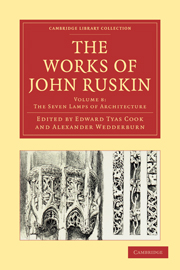Book contents
- Frontmatter
- Contents
- LIST OF ILLUSTRATIONS
- INDEX TO THE PLATES
- INTRODUCTION TO THIS VOLUME
- BIBLIOGRAPHICAL NOTE
- THE SEVEN LAMPS OF ARCHITECTURE
- AUTHOR'S PREFACE TO THE FIRST EDITION (1849)
- AUTHOR'S PREFACE TO THE SECOND EDITION (1855)
- AUTHOR'S PREFACE TO THE EDITION OF 1880
- The Seven Lamps of Architecture (CONTAINING THE TEXT OF ALL THE EDITIONS)
- INTRODUCTORY
- CHAP. I THE LAMP OF SACRIFICE
- CHAP. II THE LAMP OF TRUTH
- CHAP. III THE LAMP OF POWER
- CHAP. IV THE LAMP OF BEAUTY
- CHAP. V THE LAMP OF LIFE
- CHAP. VI THE LAMP OF MEMORY
- CHAP. VII THE LAMP OF OBEDIENCE
- NOTES BY THE AUTHOR
- APPENDIX
- Plate section
CHAP. IV - THE LAMP OF BEAUTY
Published online by Cambridge University Press: 05 November 2011
- Frontmatter
- Contents
- LIST OF ILLUSTRATIONS
- INDEX TO THE PLATES
- INTRODUCTION TO THIS VOLUME
- BIBLIOGRAPHICAL NOTE
- THE SEVEN LAMPS OF ARCHITECTURE
- AUTHOR'S PREFACE TO THE FIRST EDITION (1849)
- AUTHOR'S PREFACE TO THE SECOND EDITION (1855)
- AUTHOR'S PREFACE TO THE EDITION OF 1880
- The Seven Lamps of Architecture (CONTAINING THE TEXT OF ALL THE EDITIONS)
- INTRODUCTORY
- CHAP. I THE LAMP OF SACRIFICE
- CHAP. II THE LAMP OF TRUTH
- CHAP. III THE LAMP OF POWER
- CHAP. IV THE LAMP OF BEAUTY
- CHAP. V THE LAMP OF LIFE
- CHAP. VI THE LAMP OF MEMORY
- CHAP. VII THE LAMP OF OBEDIENCE
- NOTES BY THE AUTHOR
- APPENDIX
- Plate section
Summary
§ 1. It was stated, in the outset of the preceding chapter, that the value of architecture depended on two distinct characters: the one, the impression it receives from human power; the other, the image it bears of the natural creation. I have endeavoured to show in what manner its majesty was attributable to a sympathy with the effort and trouble of human life (a sympathy as distinctly perceived in the gloom and mystery of form, as it is in the melancholy tones of sounds). I desire now to trace that happier element of its excellence, consisting in a noble rendering of images of Beauty, derived chiefly from the external appearances of organic nature.
It is irrelevant to our present purpose to enter into any inquiry respecting the essential causes of impressions of beauty. I have partly expressed my thoughts on this matter in a previous work, and I hope to develope them hereafter. But since all such inquiries can only be founded on the ordinary understanding of what is meant by the term Beauty, and since they presume that the feeling of mankind on this subject is universal and instinctive, I shall base my present investigation on this assumption; and only asserting that to be beautiful which I believe will be granted me to be so without dispute. I would endeavour shortly to trace the manner in which this element of delight is to be best engrafted upon architectural design, what are the purest sources from which it is to be derived, and what the errors to be avoided in its pursuit.
- Type
- Chapter
- Information
- The Works of John Ruskin , pp. 138 - 189Publisher: Cambridge University PressPrint publication year: 2010First published in: 1903



